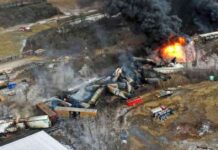For more than six months, the village of Shevchenkove in eastern Ukraine was occupied by Russia. It was released last week. With the Russian soldiers, the propaganda newspapers and the portraits of Putin have also disappeared from the village of 7,000 inhabitants. Now people are returning to normal life.
On February 25 – just a day after the start of the aggressive war in Ukraine – the village of Shevchenkove, about 80 kilometers southeast of Kharkiv, was captured by Russian troops.
More than six months later, Ukrainian soldiers recaptured the village of 7,000 in early September. “It’s like the movies,” pensioner Anatoly Sukhomlyn tells the Guardian. His small town has witnessed an invasion and a liberation in just a few months.
For the past six months, Shevchenkove has been a different village than before for its residents. “They just came and occupied us,” a resident told US broadcaster CNN last week. Little was made public during this period. Residents were forced not to say anything. Even today, most people don’t want to comment, reports CNN. However, individual residents tell of life under occupation.
The banks were closed. The residents could not have bought anything in the shops. From 8 p.m. to 6 a.m. they usually had no water, 73-year-old Larisa Kharkivska tells CNN. What the Russians distributed, however: a propaganda newspaper. From the radio, too, only tales of the Russian victory came.
Meanwhile, a portrait of Kremlin boss Vladimir Putin hung in the mayor’s office in the town hall. Next to it a Russian flag. Russian collaborator Andrei Strezhko spoke at city hall about referendums on Russia’s accession and curricula that didn’t include Ukrainian stories, the Guardian writes.
“We tore it up,” says military administrator Andriy Konashavych. about the portrait. And Strezhko? He is believed to have fled across the border to Russia when Ukrainian troops retook the village.
According to Konashavych, the Russians told the villagers that they would stay in the city forever. A small minority collaborated with the occupiers, the rest tried to survive, he says. Russian intelligence arrested and interrogated some after breaking into garages and examining computers, pensioner Anatoly Sukhomlyn tells The Guardian. Another resident told The Guardian that all residents were checked for Ukrainian patriotic tattoos.
Locals said that troops kept withdrawing, then new ones came – from different parts of Russia, and also from Siberia. You wouldn’t even have noticed many of them.
Soldiers would often lie drunk on park benches. In Russian military police buildings there were punishment cells: big enough for a chair, but too small to lie down. “The Russians treat people like beasts. We believe that they imprisoned their own deserters here,” says prosecutor Roman Erokhin, adding: “It could also have been Ukrainian prisoners.”
During the successful counter-offensive, President Volodymyr Zelenskyy said that after the occupation the areas must return to normal life. Shevchenkove hardly knows normality as it used to be.
But the relief of the people outweighs it. The 73-year-old Larisa says to “CNN”: “We survived, thank God, we survived! But it was very scary. We just hope they never come back.”
When the Ukrainian soldiers liberated the city, pensioner Sukhomlyn cheered for them. “This is my country. I was born here and will die here,” he says.















